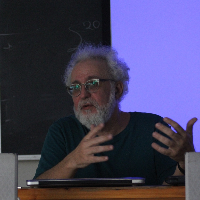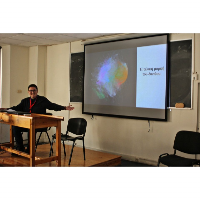Preprint
Article
Emotions during the Pandemic’s First Wave: The Case of Greek Tweets
Altmetrics
Downloads
151
Views
86
Comments
0
A peer-reviewed article of this preprint also exists.
This version is not peer-reviewed
Preprints on COVID-19 and SARS-CoV-2
Submitted:
09 December 2023
Posted:
12 December 2023
You are already at the latest version
Alerts
Abstract
While most published research on COVID-19 focused in a few countries and especially during the second wave of the pandemic and the vaccination period, we turn to the first wave (march-May 2020) to examine sentiment and emotions expressed by Twitter users in Greece. We use computational methods combining opinion mining and the application of a modified emotion lexicon with Social Network Analysis to explore the subtleties behind an overarching negative sentiment. Our analysis has shown that popular sentiment isn’t stable nor monolithic, since underlying emotions may be a better predictor of attitudes during a crisis.
Keywords:
Subject: Social Sciences - Media studies
1. Introduction
Research on social and emotional reactions to COVID -19 is already quite extensive, although for the most part it is descriptive and geographically limited. Even more descriptive, focused, and lacking depth are the publications concerning the first wave of the pandemic, until the end of spring 2020, which tried to capture the concerns rather than to articulate a substantial scientific discourse. In contrast, publications dealing with fall 2020 or attitudes toward vaccination are more mature, both in terms of content and methodology.
The SERP 19 project aimed to understand the social and emotional effects of the pandemic and the first lockdown period in Greece, and to compare them with the corresponding effects in two more member countries of the European Union, namely Italy and Germany. These countries were chosen because of the significant differences they presented to the Greek case: while Greece came out of the first wave of the pandemic successfully, and was considered a role model, Italy was among the countries that suffered the most in cases and death toll. Germany did not suffer as much, but its citizens expressed higher trust to public authorities compared to Greek citizens.
To achieve this goal we had to turned to the discourse of the subjects, as it emerged spontaneously in the period we were interested in, motivated either by the news about the evolution of the pandemic, or by the public discourses and measures imposed by governments, from the fears created by the above but also from the illness of relatives, friends and acquaintances, or from the discussion on social media – given that face-to-face discussions could not take place outside the household.
During the first year of the pandemic (January 2020-January 2021) the number of social media users worldwide increased by 13.2%, (or by 490 million users). The most popular platforms at the end of 2020 were Facebook, Youtube, WhatsUp, Messenger and Instagram. Twitter ranked 16th in popularity with 353 million users worldwide. The increase in social media users during 2020 was for Greece 9.7% (+650,000 users), in part due to the containment measures limiting mobility during lockdown, which turned the global public towards telecommuting and online entertainment. The transfer of most activities online boosted activity on social media. Twitter was the only popular social medium allowing data collection from public accounts.
In this paper we present the evolution of the characteristics of the collected tweets from Greece during the three months of the first wave of the COVID -19 Pandemic (March-May 2020), which covers the spread of the pandemic in the European countries, the World Health Organization declaration of COVID-19 as a pandemic (March 11, 2020), the gradual imposition of measures and restrictions on movement (lockdown), to their gradual lifting during May 2020. In the following we present a review of the publications related to the debate about the pandemic on Twitter, including the sentiments and emotions expressed by the users, as well as the spread of disinformation – which the World Health Organization warned about from the beginning, characterizing it as a pandemic of misinformation (infodemic) – and conspiracy theories. The second section is dedicated to the presentation of the research methodology. It covers the choices we made for data collection (data mining) and its limitations, ethical issues, the methodology adopted based on social network analysis, sentiment analysis, and discourse analysis. The third section presents the analysis for Greece. It presents a concise timeline of the most important events, the evolution of the volume of tweets and retweets, the analysis of the network of users per month, the presentation of the main topics and the evolution of emotion.
1.1. Literature Review
Publications on the relation between social media and their use during the pandemic highlighted their role as a means of disseminating (dis)information and fake news, as well as a means of shaping public opinion, education, direct communication between the public, the state, institutions, and stakeholders, along with surveillance [1]. The first wave of the pandemic caught both national and international governments as well as the scientific world off guard. Research into the analysis of sentiment in Twitter is quite limited, while published papers are mostly about India and the USA, and only one out of four adopting a global perspective. Although the countries suffering most during the first two months of the pandemic were Italy, France, Germany, and Spain [2], published research did not follow the epidemiological map at the time. During the second wave, the second lockdown, the emergence of new mutations of Covid -19 and vaccination, the interest of the scientific community on the relation between Twitter and sentiment about the pandemic heightened and became more internationally oriented.
We analyzed 141 papers found in a Scopus search, combining sentiment and emotions or disinformation during the pandemic on Twitter. The network of keyword co-occurrence (Figure 1) captures the distinction between papers emphasizing computational techniques (the left, red and purple part of the graph) and those focusing on social issues (the right, green and blue part of the graph). Most of the papers were focusing on the second wave and the vaccination, leaving aside the first wave. On the other hand, most papers used corpuses with English tweets, or tweets in other languages machine translated to English, thus discarding cultural and national differences.
The study of sentiment highlighted negativity during the first wave, attributed to the gravity of the pandemic combined with the lack of medication [3]. On the other hand, the study of the trauma accompanying such stressful situations reveals that people were initially negatively disposed towards the new and threatening situation, prone to focus on negative events reinforcing existing negative emotions [4-5]. In the case of Italy, the first period was marked by high levels of negative emotions and fear, due to growing anxiety and uncertainty, but after that and despite the strict measures, sentiments were back to normal, even reporting emotions such as boredom [4].
Uncertainty and fear were not the only factors behind negative emotions. Socio-political developments and the unprecedented ‘violent’ subversion of the social contract caused a widespread social discomfort. Despite national differences, a correlation was found between socio-economic events and negative emotions, as well as between the containment measures taken by the governments and an increasingly obvious social discontent. The increasing expression of negative emotions, mostly of isolation and depression, was related to government practices, as well as to economic consequences, as e.g., in Mexico [6]. In the latter case, negative emotions were associated with positive concepts such as rescue and recovery, attributing greater intensity to social discomfort. Similar were the findings in Korea and Japan, with an emphasis upon the impact of containment measures upon everyday life, or the cancellation of the Olympic Games in Japan [7].
At the micro level, the problems faced in European countries, despite horizontal measures adopted by the EU, caused negative emotions such as rage, anger, and fear. Research in Arabic-speaking countries [8] also found emotions of rage, anger, and fear, followed by disgust and sadness. In other cases, anger was found to be related to social isolation, and many Twitter users reported that being isolated in hotels without institutional support made them feel like criminals [9]. Such findings indicate a crisis of trust towards political authorities and institutions [10], which was quite loud when vaccination was around the corner. While diffuse emotions of fear, anxiety and anger remained relatively stable since the beginning of the pandemic, the center of gravity shifted towards certain sectors of politics, economy, and specific practices in the management of the pandemic.
Research regarding the expression of emotions in Twitter in Greece during the first wave of the pandemic is extremely limited. According to [11], tweets using Greek and international hashtags on coronavirus, were associated with positive emotions during the first wave of the pandemic. Official campaigns such as #menoume_spiti (i.e., ‘we stay at home’) were instrumental, highlighting a high level of compliance and trust shown by Greek citizens towards the government and EODDY (the Greek Organization for Public Health). This situation was gradually overthrown when the discussion shifted to topics such as the opening of markets and schools, the restart of economy and the official announcement of the tourist season. The fluctuation of sentiments followed a different path than other countries. The initial optimistic attitude was replaced by negative emotions such as fear and anxiety, which were also expressed through practices such as uncontrollable hoarding of goods. Especially during the first wave, there was a strong tendency to help each other with an exhortation for social distancing, compliance with the containment measures and personal responsibility. [12] also studied emotions in Twitter during the first wave of the pandemic, but their focus was on English tweets by Greek users. Using the Paul Ekman classification, they found that the most frequent emotions were surprise at the emerging contagion, and anger over the imposed isolation, leading to a “fear versus anger” response. [13] focused on the second wave, and they aimed at evaluating the accuracy of existing sentiment and emotion lexicons. They found a diminishing interest in tweeting about COVID-19, lower positive polarity than in other countries, while the dominant emotions were surprise, disgust, and anger. Other papers discuss sentiments related to Long COVID [14], and vaccination [15].
Our research complements these studies in providing an in-depth analysis of tweets posted during the first wave using a wider spectrum of country-specific covid-related hashtags, as described in the following section. It is diverging from published research in adopting a complex theory of emotions, involving eight basic, twenty-four combinations or dyads, and four opposite emotions. Finally, it makes use of social network analysis to examine the emotions expressed by different groups with divergent or opposing interests.
2. Materials and Methods
In this section we detail data mining, and compliance to ethics in Twitter use. We then proceed to the description of the data, and the criteria for choosing tweets and enhancing our corpus. A concise presentation of Plutchik’s theory of emotions and its operationalization in Natural Language Processing and opinion mining with the use of NRC Word-Emotion Lexicon, is followed by social network analysis basics, focusing on the metrics used in our research.
2.1. Data Mining
Data mining is a complex process, especially at the scale attempted for this project. The project covers an extensive period, and our goal was to sample data from all tweets shared throughout this period. Data acquisition had to follow a uniform policy for the entire period, to limit bias. Therefore, we examined available datasets in academic repositories, covering the first wave of the pandemic (March-May 2020). We chose to use the «COVID -19 Twitter Dataset» [16], which, according to its description
…contains 237M Tweet IDs for Twitter posts that mentioned "COVID" as a keyword or as part of a hashtag (eg, COVID-19, COVID19) between March and July of 2020. Sampling Method: hourly requests sent to Twitter Search API using Social Feed Manager, an open source software that harvests social media data and related content from Twitter and other platforms. NOTE: 1) In accordance with Twitter API Terms, only Tweet IDs are provided as part of this dataset. 2) To recollect tweets based on the list of Tweet IDs contained in these datasets, you will need to use tweet 'rehydration' programs like Hydrator (…) or Python library Twarc (…). 3) This dataset, like most datasets collected via the Twitter Search API, is a sample of the available tweets on this topic and is not meant to be comprehensive. Some COVID-related tweets might not be included in the dataset either because the tweets were collected using a standardized but intermittent (hourly) sampling protocol or because tweets used hashtags/keywords other than COVID (eg, Coronavirus or #nCoV). 4) To broaden this sample, consider comparing/merging this dataset with other COVID-19 related public datasets…
As noted in the description, the data is presented in a ‘dehydrated’ format, that is, it is a list of the unique identifiers (ID) of the tweets. This is generally accepted as the ethical way to disseminate Twitter datasets, as it ensures that any subsequent researcher will repeat the data collection, leaving aside tweets deleted, turned private, or posted by a deleted account. Such a procedure also complies with Twitter’s guidelines during the data collection period. Data ‘hydration’ was completed using the twarc2 library for Python programming language.
2.2. Enrichment of the Greek Corpus
The corpus of Greek tweets was limited, due to the use of English-only hashtags during the original data collection procedure. This posed obstacles to mining tweets from countries using hashtags in non-Latin alphabets or country-specific hashtags (such as #covid19gr). Such a limited corpus also meant limitations to its scope, possibly excluding significant topics of national importance or even niche subjects and fake news or conspiracy theories. We took the following steps to enrich the corpus:
- Selection of tweets identified as using Greek language. Reconstruction of the network of hashtags used in those tweets.
- Hashtag network analysis: This network is an undirected graph capturing the co-occurrence of hashtags in the same tweet, creating an edge for each pair of hashtags (Figure 2). We identified groups of hashtags appearing together more often. Different attitudes towards the pandemic or containment policies are expected to use different hashtags. The nodes were ranked according to PageRank algorithm [17], which calculates both the degree of a node (i.e., the number of its connections to other nodes) and the connection to important nodes (highly influential nodes) [18].
- We selected 20 hashtags with the highest PageRank, excluding non-country-specific and includong hashtags from various groups (modularity classes), to ensure diversity.
- A search was conducted with those 20 hashtags, to produce the final corpus of Greek tweets.
2.3. Restrictions
Data collected through Twitter Search API is a fraction of the total volume of the actual tweets. This fraction is determined by the algorithm, while an exact percentage is not mentioned. Data aggregation of the original corpus was completed in certain time frames, thus tweets posted outside these time frames were ignored. Finally, as the search was made with a generic hashtag, tweets using other hashtags were also ignored. This led to a limited representation of languages where the use of English hashtags is not common practice.
On the other hand, such restrictions are relevant when considering gaps at the ‘fringe’ of the debate, where fake news, conspiracy theories and misinformation are spreading. When they use unconventional hashtags, they go ‘under the radar.’ A different data-collection strategy should be employed, were we looking for such tweets, as described for example in [19-22].
2.4. Sentiment Analysis
The idea of sentiment analysis is not particularly new. It can be traced, for example, to the analysis of sentiment as reflected in newspaper texts at the beginning of World War II [23], however it is flourishing with the application of computational methods in Digital Humanities. [24] attribute this sudden ‘explosion’ of interest to the development of new systems for opinion expression and evaluation of products, services, etc. Indeed, the participatory Web 2.0 enabled users of services and products to rate them and describe their experience justifying their ratings. Upon realizing that “consumer voices can wield enormous influence in shaping the opinions of other consumers — and, ultimately, their brand loyalties, their purchase decisions, and their own brand advocacy” [24] (p. 4), sentiment-aware applications were developed.
The use of lexicons matching specific words with positive, negative, or neutral sentiment is widespread in Digital Humanities. This technique compares each word within a document (a tweet in our case) with the words in the lexicon and applies the term frequency inverse document frequency (TF-IDF) statistic as a means of weighting the positive, negative and neutral words in relation to the total number of words in the text. We used the NRC Word-Emotion Association Lexicon (EmoLex) [25-26], providing annotations for two sentiments – positive and negative – and eight emotions – anger, anticipation, disgust, fear, joy, sadness, surprise, trust. They are related to Plutchik’s evolutionary theory [27-30], which conceives emotions as “a complex chain of loosely connected events that begins with a stimulus and includes feelings, psychological changes, impulses to action and specific, goal-directed behavior” [30] (pp. 345-346). He argues that emotions such as fear and anger are common to all living organisms, while pairs of emotion produce complex feelings (dyads and opposites) more compatible with human nature. The outcome of sentiment analysis is presented in the form of ‘Plutchik's wheel’ (Figure 3). The Python library pyplutchik [31] was used to produce emotion wheels according to our research.
The EmoLex lexicon has been used by [32-38] in the analysis of emotions during COVID-19.
Previous research has shown that the automatic translated English lexicon into other languages along with its linguistic limitations [39] and field specific deficiency [40] should be amended to achieve better outcomes. In our analysis an amended version of the Emolex dictionary has been used, produced by Sofia Messini for her doctoral thesis.
2.5. Social Network Analysis
In its basic form a social network describes the interaction between social actors. The actors are represented as ‘nodes’ or ‘vertices,’ while the interactions as ‘edges’ connecting the nodes. The more intense the interactions between two nodes, the stronger the edge between them. Social networks may be quite complex, and social network analysis (SNA) may be used in very diverse contexts ranging from predicting political behavior and election outcomes, to the spread of epidemics [41-43].
Despite its widespread use in social media analysis, only few publications used SNA on Twitter data during the COVID-19 pandemic. In most cases, their aim was to figure out opinion leaders, guiding the polemics between mainstream positions and partisan opinions which were sometimes prone to misinformation and conspiracy theories [44-50]. Though such approaches involve recognizing discrete communities within the network, only [51] emphasized the search of such communities or “clusters expressing mistrustful opinions on COVID-19 vaccination.”
In this paper we reconstruct the networks of reactions between Twitter users, including mentioning, replying, retweeting, quoting, or liking. We employ SNA algorithms to discern communities within the network and locate opinion leaders or ‘significant others’ expressing the opinions and attitudes of each community. “A community is a locally dense connected subgraph in a network. (…) all members of a community must be reached through other members of the same community. At the same time, we expect that nodes that belong to a community have a higher probability to link to the other members of that community than to nodes that do not belong to the same community” [41]. Communities are pivotal in network dynamics, by supporting co-operation within and promoting diversity in the complete network [52]. The idea that communities display some degree of conformity, by sharing common interests, perceptions, and ideologies, has been the foundation for recognizing the feature of homophily in networks [53-54, 41]. To compute communities within our networks, we used modularity algorithm [55]. To locate important nodes within each network, we employ centrality measures, based either on the number of connections (degree centrality) or on influence through being close to well-connected neighbors (closeness centrality) or being connected to the most influential nodes (eigenvector centrality) [18].
3. Results
The first case of the COVID -19 pandemic in Greece was detected on February 26, 2020, the first ICU hospitalizations were announced on March 4, while the first death occurred on March 12.
The tweets we collected from March-May 2020 (Figure 4) display an overall declining trend after peaking on March 13-15, when the first deaths from COVID-19 were announced, and a smaller peak a few days later (19-21 March) when the 10th death was announced. During the lockdown period (23 March-4 May), COVID-19 related tweets were significantly fewer, with a peak on April 17 as the Greek-Orthodox Easter was approaching and the churches were closed to the public, and smaller ones on April 22 and May 1. From then on, interest decreased and at the end of May the tweets per day in our corpus did not exceed 5,000.
The sentiment expressed was mostly negative (Figure 5). It seems that since April 1st and until the end of the quarantine, the expression of negative emotions became less intense. After the announcement of shifting travel restrictions (April 28) and the gradual opening of shops, accompanied with mandatory use of masks (May 4), negative sentiment intensified, because it was considered that such decisions were premature, taken only to facilitate tourism.
3.3. Emotions
3.3.1. March 2020
The strongest emotions in the Greek tweets during March were Anger, Disgust, Fear and Sadness. As mentioned, Anger is aimed at persons, while Fear is related to situations. Tweets posted during March 2020 scoring high in Anger mentioned governments, enemies, institutions, politicians, or restrictions involving exclusions by decisions made by governments. At the same time, they were referring to deaths and outbreaks, both in Greece and in other countries:
- The French government has banned public gatherings of more than 5000 people indoors because of the new coronavirus, the health minister announced.
- Hey, don't terrorize the Greeks, dumbasses!
- I have been through Measles, Chickenpox, Rubella, Lice, Chernobyl, Anthrax, Avian Influenza, Pig Influenza, Mad Cows, Ebola, Coxsackie, H1N1, economic crisis with 3-4 Memoranda, Referendum, two Mitsotakis, two Karamanlis, two Papandreou, one [Varoufakis]
- Arrests under the antiterrorism law for a publication. This is how you fight a pandemic when you hire cops instead of nurses and doctors.
- After the notorious ‘personal responsibility,’ today we learned that the government has done all right with the medical equipment in hospitals, but it is the fault of the workers who waste it. #Καλοφάγωτο #Covid_19.
On the other hand, tweets scoring high in Fear (sometimes scoring high both in Fear and Anger) focus on the casualties and risks, sometimes supported with far-right rhetoric:
- Covid-19 -Italy: The victims of the coronet in Bergamo are more than the victims of World War II. The authorities are talking about a catastrophe, according to France 2's correspondent in Rome.
- Who is afraid of “Makelio” [newspaper]? We're dying, do you understand, you miserable bastards?
- Coronavirus: high risk for covid-19 in Europe #OpenNews #OraEllados7 It has now hit 1/3 of the world's countries and worldwide the number of victims has reached 3,117 and the number of infections 90,912
- during curfew staying at home is an order of the welfare state ... and needless moving around entails a fine and maybe soon a prison sentence ... so we either "#MENUMESPITI [i.e., Stay at home] or #PAMEPHILACY [i.e., We go to prison], therefore home and prison became identical... for our sake of course.
- #Government_Mitsotakis speaks about an ‘invisible war,’ but will we go mad? The #coronavirus or other VIRUS is the WEAPON the enemy is behind the weapon e.g., weapon #illegalimmigrants ENEMY #erdogan, everything has its origin why not refer to the origin or creation of the #coronavirus? Responsible = THEM
The latter case points at persons, but in a vague and collective manner (e.g. “illegal immigrants”) or beyond the immediate environment affecting the individuals. Though many of those tweets adopt xenophobic and far-right positions, Fear is not exclusive to xenophobic and far-right users.
Disgust is also taking several forms often linking politics with pandemic. Words like “contamination,” “prohibition,” or “fraud,” are prominent in the vocabulary of Disgust:
- [An untranslatable derogatory term is used to describe the supporters of the Left party of major opposition] heckle the govt for delay (!!!) in taking measures for #Covid_19. When it banned carnivals 12 days ago, they were down on it for its “undemocratic” decision
 . Decide exactly what the hell you want, you ideological opportunists!!!!
. Decide exactly what the hell you want, you ideological opportunists!!!! - When was the last time there was a curfew in Greece??? Um....During [German] OCCUPATION???? #Coronavirus, #Greece, #KyriakosMitsotakis, #HOAX, #Cases, #Scam, #Masons, #Covid
- The Turk is waiting for the right time to strike. That time is approaching. In 20 days, there will be queues outside hospitals waiting for hospitalization, people will be in panic. Then he will strike. Watch and pray #coronavirus #Evros #migration #Greece_under_attack.
- #Coronavirus epidemic of WORLDWIDE PSYCHOPATHS terrorizing, committing crimes with the DIRT of soul and body excretions!
- I can deal with #menume_spiti [i.e., We stay at home] for as long as it takes, but I can’t fight dumbass, indifference, selfishness and the criminal incompetence of the government and all politicians #coronavirus.
Grief is also expressed in a variety of ways ranging from regret for the news about the pandemic, to frustration at the attitude of politicians or society at large, sometimes adopting an aggressive rhetoric:
- It is smelling... death in Europe, as deaths from the new coronavirus are rising rapidly, with Spain surpassing China in the number of deaths.
- #Tsiodoras [i.e., the head of the Greek National Public Health Agency] “PLEASE keep what we tell you!” what a plea! curse the idiots who don't #MENUMESPITI [i.e., We stay at home] #we_are_homeless ! pleas are too weak! Use a whip!!!!
- #Coronavirus here is Balkans but the nudity of the 'prosperous' Europe who entangled our countries in memorandums, wars, and 69 innocent souls are considered as a detail, without underestimating the tragedy of death in the face of ethnic cleansing in Italy for example!
- These days that we are delaying the compulsory closure of the country at home – because that will happen eventually – bring more deaths. In a country where the very enforcement of the law is optional, the recommendation to stay home and a video add with Spyros Papadopoulos is not enough. #MENUMESPITI
In Figure 6 the dominance of Anger throughout the month is clear, as well as the decrease of Fear after the first few days and its replacement by Disgust. After mid-March Sadness gained impetus, alternating in third position with Fear.
Turning from the big image to the larger groups (modularity classes) of users, differences among the emotions expressed become illuminating: The larger group, was quite involved in the debate on the Greek-Turkish crisis before turning to the discussion on the pandemic. As the last days of February were marked by a sudden opening of the Turkish-Greek border by Turkish authorities so that some thousands of refugees or immigrants could enter Greece, despite a previous EU-Turkish agreement [61]. The first week of March the crisis was active, and the news about the pandemic paved the way to a xenophobic discourse connecting refugees with a potential threat to diffuse COVID-19 in Greece [62-63]. This group is hosting both the xenophobic and the xenophilic voices. It expressed Anger and Disgust from 13 March onwards, feelings which become more systematic and intense from 20 March onwards, along with Fear and Sadness. After the lockdown is imposed, Trust was also expressed by the users in this group, peaking between March 27 and 29. The less partisan second group, humoristic accounts such as “Undertaker Boukouras” and journalists were among the most mentioned. Tweets in this group sometimes expressed left-wing criticism of the government or displayed photos with beaches. During the first half of March, users in this group expressed stronger emotions of Anger, Disgust, Fear and Sadness. Later, positive emotions of Joy, Trust and Surprise intensified above average. The third group was created around mentions to the Right. In early March, users in this group expressed Anticipation, Fear, Sadness and Surprise. In fact, on March 1st Fear reached the highest value recorded for any group during this month. Then Anger and Disgust intensified, while Sadness and Surprise receded. Anticipation was intense until the first containment measures were announced. Afterwards, it was replaced by Trust. A more “institutional” group, with tweets mentioning the Prime Minister, the Minister of Health, the National Public Health Agency, presented a neutral emotional footprint. It was only the last three days of March, that they scored high in Anger, Disgust and Fear. As neutral was the emotional footprint of the fifth group, associated with SYRIZA or the broader Left.
3.3.2. April 2020
In April a daily update on the pandemic became part of a nationwide ritual. On some days massive outbreaks were discovered in shelters for refugees, elderly people, neighbourhoods, health units, etc. The most important dates in April were:
- On April 8 control over violating containment measures and mobility restrictions was upgraded, fines were doubled, and churches were announced to remain closed until April 28 in view of the Easter celebrations (19 April),
- On April 14 the death toll exceeded one hundred deceased persons in Greece,
- On April 17 a decision to provide lifelong learning aiming at freelancers and professionals in fields like medicine or engineering, as a means to financially aid to them due to lockdown, was uncovered as a scandal when the content was proved to be machine-translated of dubious quality,
- On April 28 the end of the lockdown and the phasing out of the containment measures was announced.
The strongest emotions expressed in Greek tweets during April were still Anger, Disgust, Fear and Sadness, but their scores were slightly lower than in March. The implementation of the lockdown followed a series of measures, establishing a clear framework that – despite reactions – provided security for citizens. Tweets posted during April 2020 scoring high in Anger were aiming at the government, politicians, the media and people who allegedly ignored protective measures and got sick. Some exemplar tweets were the following:
- #antireport #Covid_19gr #curfew The following example shows how TV channels are presenting their shots so that the burden of responsibility continues to fall on the “undisciplined” people who are walking on beaches and parks...
- I don't know about you, but I haven't seen anyone from SYRIZA uploading proof of deposit of 50% of their salary, unlike the members of the New Democracy party..... It's probably a coincidence
 #SYRIZA_exploiters #curfew #carantine #Covid_19 #StayHome #lockdown
#SYRIZA_exploiters #curfew #carantine #Covid_19 #StayHome #lockdown - We won't die at home... Strengthen the National Health System... You are potential murderers @PrimeministerGR @Vkikilias #curfew #Covid_19 #MENUMESPITI
Fear in April’s tweets was taking concrete forms as well: fear of a bleak future; fear of the consequences from the collapse of the health system; and conspiracy theories suggesting that COVID-19 and the pandemic were a means of political management through mobility restriction and fear. Typical tweets scoring high on Fear were the following:
- What will be left after the “pandemic”? A new memorandum, massive unemployment and poverty, suicide attacks from fundamentalist Muslims and State terrorism with repeated quarantines.
- Tragic images from Ecuador under total collapse of the health system: woman whose husband died in her home and stayed there for two days, “I’m not afraid of death, but I don't want to die like this” #Covid_19 #we_stay_at_home.
- The “scientific décor” of the Stalinist Junta #ND_deceptions should (1) release DEATH CERTIFICATES and (2) DO NECROPSY. Scammers with the FAKE #coronoius you are destroying the ECONOMY and SETTLE DOWN millions of baboon assassins #GoAway.
- For everyone else, political management is a) fear mongering b) incarceration c) disappearance of any reaction to the Legislative Acts d) broken health care system ---> regime incompetence. #covid19Gr.
High scores on Disgust or Sadness were in most cases combined with Anger and Fear. In Figure 8 the continued dominance of Anger throughout April is clear. Disgust maintained the second position, exceeded by Fear only on scarce occasions. Sadness and Fear were competing for the third position.
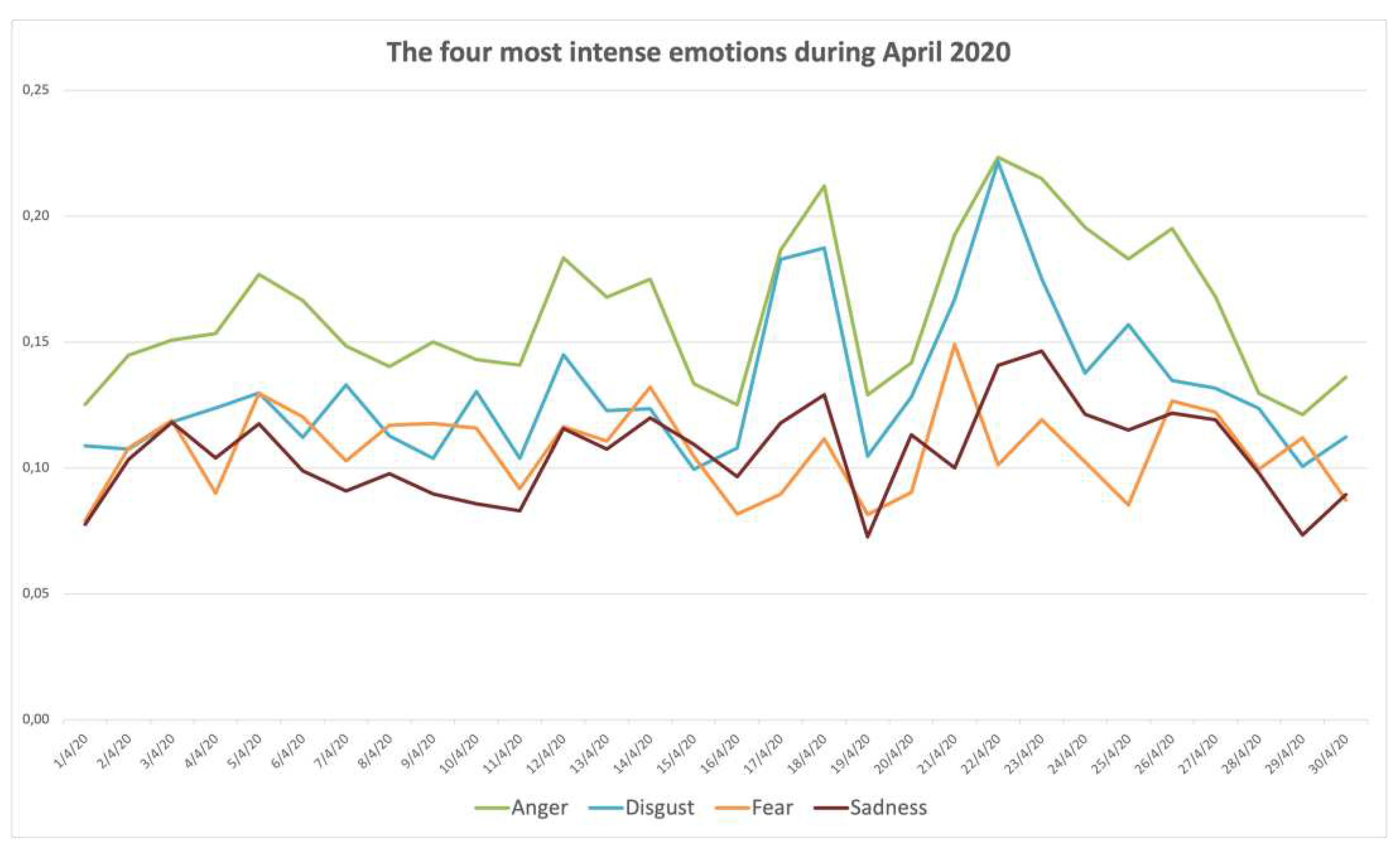
Figure 7.
The fluctuation of the four most intense emotions expressed in the Greek tweets during April 2020.
Figure 7.
The fluctuation of the four most intense emotions expressed in the Greek tweets during April 2020.

The larger groups (modularity classes) of Twitter users were reconfigured during April. The first group was composed by those who mentioned of the ruling party of New Democracy executives, Prime Minister’s Kyriakos Mitsotakis personal account and Sotiris Tsiodras – the representative of the National Public Health Agency. Negative sentiments scored in this group higher than average. This is due mostly to the very high scores of Anger and Disgust and to a lesser extent to Fear and Sadness. Though, it should be noted that the tweets related to the aforementioned scandal were aimed both to the government, and to its critics. Thus, while mentioning the government officials and the ruling party, negativity wasn’t single-mindedly targeting them, but also it was targeting the ex-ruling opposition party. A second source of Anger expressed in the tweets of this group was the prohibition of liturgy in churches during the Greek Orthodox Easter. The second group was also a field of confrontation between users supporting the opposition party SYRIZA (mentioning its leader and party executives) and the ‘Truth Group’ (an account promoting the ideas and policy of New Democracy in a populist manner) or some of its most active supporters and journalists. This is reflected in the emotion scores, especially those of Anger, Disgust, Fear and Sadness, with a peak on April 1st, and again in the scores of a combination of Anger and Disgust between 18 and 24 April. The third group was populated by users supporting SYRIZA or the Left in general, but the emotion scores were close to the overall average. In general, they adopted a critical attitude towards the government and those who uncritically accept its decisions. The fourth group was populated by users who mentioned leftist accounts and collectives asking for organizing mutual support between citizens during the lockdown, promoting solidarity and supporting social and political mobilizations – such as the students’ demonstrations and marches against the creation of University Police. Beyond the four dominant emotions, this group scored high in Trust and Anticipation.
3.3.3. May 2020
The public discourse reflected the gradual lifting of restrictions from the 4th May onwards, the opening of secondary schools, and the optimistic forecasts from epidemiologists, in the optimistic belief that the pandemic would end soon. This belief was supported by the statements of epidemiologists who reported that the high temperatures during summer leave no room for spread of COVID. The month started with controversy around a rally organized by trade unions related to the Communist Party, despite the measures taken and social distancing. The controversy would be kept alive as professionals affected by the containment measures went on protests. On 20 May the Prime Minister announced measures of financial support to businesses. Finally, on 25 May travel to the islands was allowed and the opening of restaurants was announced.
Anger, Disgust, Fear and Sadness remained the top scoring emotions, though Disgust, Sadness and Fear scored very close. Anticipation scored higher than the previous months, as restrictions were lifted and people were thinking about the future, often with concern. After a month with containment measures which proved successful, a new uncertain situation was ahead, and uncertainty is reflected in the dramatic increase of negative sentiments and the increasing gap between positive and negative sentiments.
Exemplar tweets scoring high in Anger during May 2020 were:
- Imagine them updating us every evening at 6pm (those left alive) on the evolution of #Covid_19 in Greece. A Nightmare on Elm Street
 And then you tell me there are no miracles
And then you tell me there are no miracles
- @Apotis4stis5 Brigand Davelis, Mitsotakis family and the “success story” with the masks #May_Day #coronavirus #mask #COVID19 #COVID 19 #Nordwest: The article...reads: “...behind all this is an effort to attract tourists...”
- So today I watched carefully the whole session of the Parliament, the briefing at six […] Conclusion: those who don’t have low income or a business of more than 200 people are screwed.
- "For flu we have a vaccine, for #covid_19GR we don’t. Do you understand the difference?" All the years we’ve had a flu vaccine did deaths cease, you idiot??? #Parliament #corona #Covid_19.
- Twitter allows access to our coronavirus-related tweets, to scientists and public crisis management and civil protection officials! The purpose, is to investigate misinformation, they say...
- Prosecutors and police authorities closed their eyes. They only know how to persecute Greek Orthodox citizens! #May_Day #left #anti-Greeks #PAME #Government_Mitsotakis #quarantine #corona #banning_traffic #Orthodoxy [For communist trade union’s May Day rally]
The return to an intermediate situation, with restrictions but no lockdown, has brought to the fore broader debates: from the continuing debate between restrictions on Easter celebrations (and therefore a form of ‘imposition’ on ‘the people of the Church’) and the communist trade union’s rally without imposing fines or other consequences, to conspiracy theories which were beginning to include vaccines, while users were concerned about access to their tweets, to the partisan debate and to concerns about the economic survival of the private sector. Such tweets combine Anger with the other high scoring emotions, namely Disgust, Sadness and Fear.
As shown in Figure 8 Anger was no longer the highest scoring emotion throughout the month, since on some days it was overthrown by Sadness. Sadness, Disgust and Fear alternate positions throughout the month, indicating the emotional frustration and concern about what was to come, which is reflected in the increase of Anticipation.
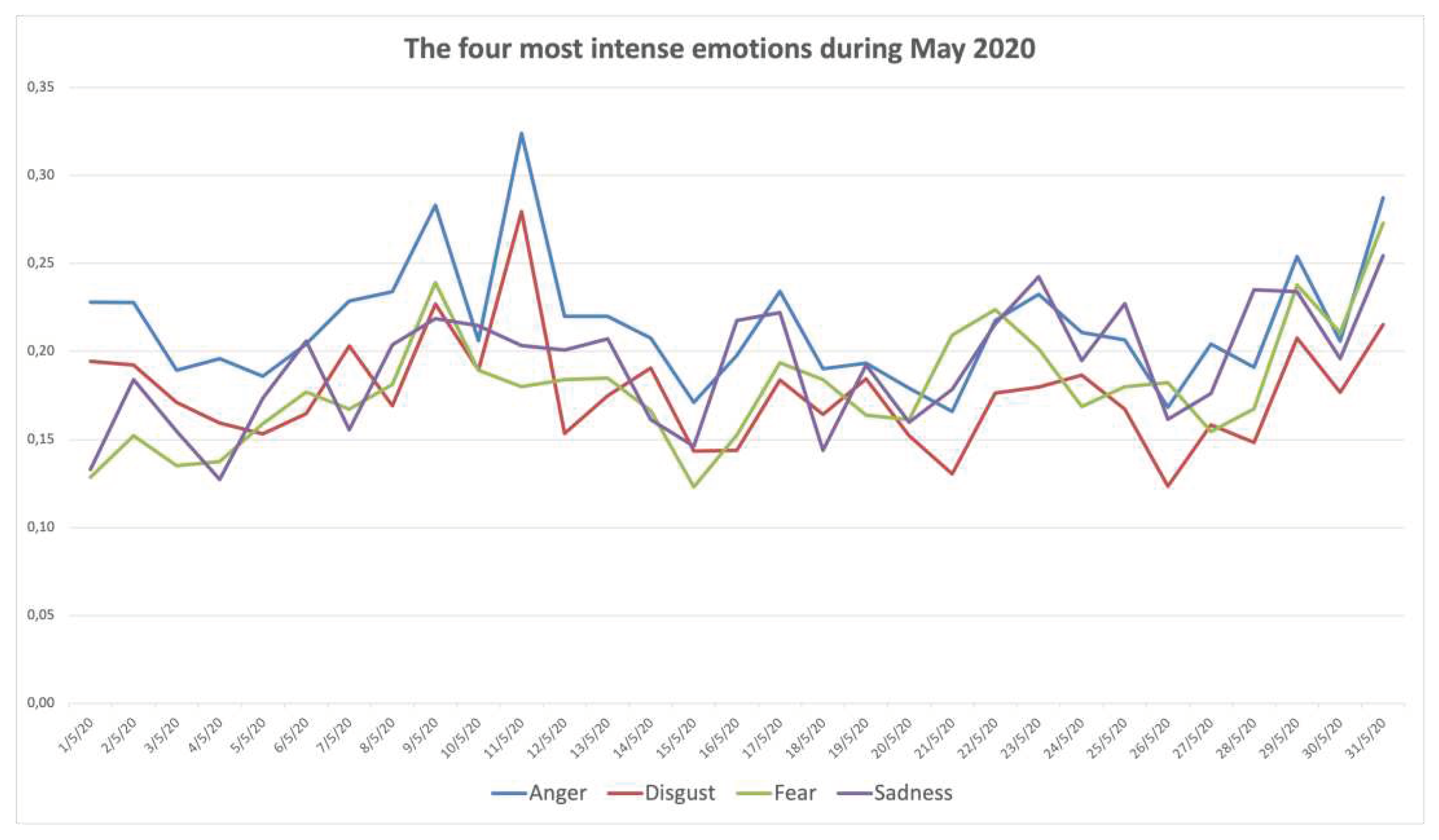
Figure 8.
The fluctuation of the four most intense emotions expressed in the Greek tweets during May 2020.
Figure 8.
The fluctuation of the four most intense emotions expressed in the Greek tweets during May 2020.

The larger groups (modularity classes) of Twitter users were reconfigured once again. The more populated group was affiliated to the opposition, joined by the hitherto independent group of a medical doctor, who had become a standard point of reference for the critical approach to the government's policy towards the pandemic. This group’s tweets expressed Anger and Disgust well above average, directed to government’s policies. Among the tweets combining Anger and Disgust, there are references to the May Day rally and rallies organized by the far (extra-parliamentary) Left, which are treated as a response to the deprivation of freedom. There is often a comparison between events approved by the government or its supporters, and rallies in open space that the government attempted to disperse through police violence. The second group is close to the governing party of New Democracy, joined by the hitherto distinct group of partisan accounts. One more group was populated by users mentioning government officials, the Athenian-Macedonian News Agency, and pro-government media. Here too, Anger and Disgust were the top scoring emotions, as it presents an aggressively anti-communist discourse, paired with racist and xenophobic utterances, and denial of using face masks. The fourth group is mostly mentioning humorist accounts such as Undertaker Boukouras, and many tweets reveal a light-hearted attitude, along with more serious concerns, such as questioning why in March the government officials discouraged the use of masks making them mandatory in May. The most active accounts were broadcasting news and gossip about showbiz. It is therefore not surprising that the emotions expressed by the users participating in this group were close to the overall average scores. The fifth group was mentioning mostly accounts of anarchists and collectives raising demands for solidarity, support for lonely people during the period of quarantine and social distancing measures, but also the collective political requests. Thus, this group lies at the opposite end of the previous groups, scoring very low in Anger, Disgust, Sadness and Trust, and lower than average in the remaining emotions. Thus, this group had the lowest negative sentiment index.
4. Discussion
During a period of uncertainty, it is expected that negative sentiments would prevail. Such a knowledge is self-evident and was documented in Sociology since Émile Durkheim’s treatise on suicide [64]: sudden changes in the socioeconomic situation are causing anxiety – not only when change is for the worst but also when it is for the better. It is tha pace of change, its rapidity rather than its direction that causes anxiety, or negative sentiment in general. This would support our finding that not only the news about the spreading of the pandemic and the imposition of containment measures – with lockdowns being the most important – but also what was considered as a premature lifting of such measures, both intensified negative sentiments.
Monitoring user-generated content in social media provides valuable insights into popular sentiment in a non-intrusive, less biased manner than traditional methods such as polls or survey questionnaires. It allows for constructing time-series and examining the impact of external factors like information about the development of the pandemic, media content and policy measures upon popular sentiment.
In the case presented in this paper, we found a diminishing interest in the pandemic per se on behalf of Twitter users, which might imply that side-issues gained in popularity. It has been noted in previous research [4] that even in countries paying a high toll in deaths, people came to express boredom, as new forms of everyday routine had been established. We found that in the period between imposing and lifting containment measures the distance between recorded positive and negative sentiment was minimal, in comparison to the preceding and following periods. In its own terms, though, this distance was important and had an impact upon media messages’ success and obedience to policies and rules.
With the use of a modified emotion lexicon, we were able to follow the fluctuation of the most intense emotions throughout this period, thus going deeper into understanding the content of the prevailing negativity. For the most part of the three-month period Anger was the prevailing emotion. By the end of May, though, it was superseded by Sadness. Indeed, though during March and April the hierarchy of the four most intense emotions (Anger, Disgust, Fear and Sadness) was rather stable, after lifting the containment measures it was destabilized. This destabilization may have been due not only to uncertainty about the pandemic, but also to the realization of its economic impact upon personal income.
The application of computational methods and their triangulation allowed for segmentation of the public and following the emotional status of each segment. Greek Twitter users formed groups mostly based on political partisanship. For both the ruling party and the party of major opposition two respective groups were formed: one was rather ‘institutional’ while the other was rather ‘populist’ or ‘militant.’ While the former group of each party adopted a mild emotional expression, closer to neutrality, the latter ones were ‘louder’ and participated in a mutual blame game. Besides those groups, though, we were able to locate other, either humoristic non-political groups around accounts adopting a humoristic outlook to fight emotional stress, or groups at the fringe of the political spectrum prone to xenophobia and conspiracy theories.
Such findings propose an innovative methodology for monitoring popular sentiment during crisis, as well as the segmentation of national audiences, thus achieving a better understanding of overarching sentiment thanks to their breakdown into emotions. We have also shown that understanding popular sentiment as stable and monolithic doesn’t inform communication campaigns in supporting containment policies and stress the need for diversity and flexibility. Finally, our findings may be applied in different contexts, beyond public health crises, to support reliable and truthful information and combat misinformation, fake news and the adoption of conspiracy theories.
Supplementary Materials
Not applicable.
Author Contributions
Conceptualization, Y.S.; methodology, Y.S., S.M. and K.K.; data curation, K.K.; writing—original draft preparation, literature review E.R., S.K. and M.-G.M., materials and methods Y.S., K.K. and S.M., results and discussion Y.S. and S.M.; writing—review and editing, E.R., Y.S. and S.M.; visualization, S.M.; supervision, Y.S.; funding acquisition, Y.S. All authors have read and agreed to the published version of the manuscript.
Funding
This research was funded by the Hellenic Foundation for Research and Innovation (HFRI), grant number 39161/09.09.2021.
Data Availability Statement
The data presented in this study are openly available in [repository name e.g., FigShare] at [doi], reference number [reference number].
Conflicts of Interest
The authors declare no conflict of interest. The funders had no role in the design of the study; in the collection, analyses, or interpretation of data; in the writing of the manuscript; or in the decision to publish the results.
References
- Chukwuere, J. E.. Social media and COVID-19 pandemic: a systematic literature review. Journal of African Films and Diaspora Studies 2022, 5(1), 5.
- Spiteri, G., Fielding, J., Diercke, M., Campese, C., Enouf, V., Gaymard, A., ... & Ciancio, B. C. First cases of coronavirus disease 2019 (COVID-19) in the WHO European Region, 24 January to 21 February 2020. Eurosurveillance 2020, 25(9), 2000178.
- Kalaivani, A., & Vijayalakshmi, R. An automatic emotion analysis of real time corona tweets. In Advanced Informatics for Computing Research: 4th International Conference, ICAICR 2020, Gurugram, India, December 26–27, 2020, Revised Selected Papers, Part I 4 (pp. 359-370). Singapore.
- Monzani, D., Vergani, L., Pizzoli, S. F. M., Marton, G., & Pravettoni, G. Emotional tone, analytical thinking, and somatosensory processes of a sample of italian tweets during the first phases of the COVID-19 pandemic: Observational study. Journal of Medical Internet Research 2021, 23(10), e29820.
- Buchanan, K., Aknin, L. B., Lotun, S., & Sandstrom, G. M. Brief exposure to social media during the COVID-19 pandemic: Doom-scrolling has negative emotional consequences, but kindness-scrolling does not. Plos one 2021, 16(10), e0257728.
- Cabezas, J., Moctezuma, D., Fernández-Isabel, A., & Martin de Diego, I. Detecting emotional evolution on twitter during the COVID-19 pandemic using text analysis. International Journal of Environmental Research and Public Health 2021, 18(13), 6981.
- Lee, H., Noh, E. B., Choi, S. H., Zhao, B., & Nam, E. W. Determining public opinion of the COVID-19 pandemic in South Korea and Japan: social network mining on twitter. Healthcare informatics research 2020, 26(4), 335-343.
- Ali, M. M. Arabic sentiment analysis about online learning to mitigate covid-19. Journal of Intelligent Systems 2021, 30(1), 524-540.
- Gjerald, O., & Eslen-Ziya, H. From discontent to action:# quarantinehotel as not just a hashtag. Cogent Social Sciences 2022, 8(1), 2051806.
- Alhuzali, H., Zhang, T., & Ananiadou, S. Emotions and Topics Expressed on Twitter During the COVID-19 Pandemic in the United Kingdom: Comparative Geolocation and Text Mining Analysis. Journal of Medical Internet Research 2022, 24(10), e40323.
- Kydros, D., Argyropoulou, M., & Vrana, V. A content and sentiment analysis of Greek tweets during the pandemic. Sustainability 2021, 13(11), 6150.
- Geronikolou, S., Drosatos, G., & Chrousos, G. Emotional analysis of twitter posts during the first phase of the COVID-19 pandemic in Greece: infoveillance study. JMIR Formative Research 2021, 5(9), e27741.
- Samaras, L., García-Barriocanal, E., & Sicilia, M. A. Sentiment analysis of COVID-19 cases in Greece using Twitter data. Expert Systems with Applications 2023, 120577.
- Katika, A., Zoulias, E., Koufi, V., & Malamateniou, F. Mining Greek Tweets on Long COVID Using Sentiment Analysis and Topic Modeling. Studies in Health Technology and Informatics 2023, 305, 545-548.
- Kapoteli, E., Koukaras, P., & Tjortjis, C. (2022, June). Social media sentiment analysis related to COVID-19 vaccines: case studies in English and Greek language. In IFIP International Conference on Artificial Intelligence Applications and Innovations; Maglogiannis, I., Iliadis, L., Macintyre, J. & Cortez, P., Eds. Cham: Springer International Publishing. pp. 360-372.
- Gruzd, A., & Mai, P. Going viral: How a single tweet spawned a COVID-19 conspiracy theory on Twitter. Big Data & Society 2020, 7(2), 2053951720938405.
- Page, Lawrence and Brin, Sergey and Motwani, Rajeev and Winograd, Terry (1999) The PageRank Citation Ranking: Bringing Order to the Web. Technical Report. Stanford InfoLab.
- Cherven, K. Mastering Gephi network visualization; Packt Publishing Ltd., 2015.
- Godard, R., & Holtzman, S. COVID-19 Misinformation and Polarization on Twitter:# StayHome,# Plandemic, and Health Communication. International Journal of Social Media and Online Communities (IJSMOC) 2021, 13(1), 1-18.
- Kant, G., Wiebelt, L., Weisser, C., Kis-Katos, K., Luber, M., & Säfken, B. An iterative topic model filtering framework for short and noisy user-generated data: analyzing conspiracy theories on twitter. International Journal of Data Science and Analytics 2022, 1-21.
- Al-Ramahi, M., Elnoshokaty, A., El-Gayar, O., Nasralah, T., & Wahbeh, A. Public discourse against masks in the COVID-19 era: Infodemiology study of Twitter data. JMIR Public Health and Surveillance 2021, 7(4), e26780.
- Spitzberg, B. H., Tsou, M. H., & Gawron, M. (2021). Social Media Surveillance and (Dis) Misinformation in the COVID-19 Pandemic. In Communicating Science in Times of Crisis: The COVID-19 Pandemic; O’Hair, H. D., O’Hair, M.J., Eds.; pp. 262-301.
- Twohey, J. S. An analysis of newspaper opinion on war issues. Public Opinion Quarterly 1941, 5(3), 448-455.
- Pang, B., & Lee, L. Opinion mining and sentiment analysis. Foundations and Trends® in information retrieval 2008, 2(1–2), 1-135.
- Mohammad, S., & Turney, P. Emotions evoked by common words and phrases: Using mechanical turk to create an emotion lexicon. In Proceedings of the NAACL HLT 2010 workshop on computational approaches to analysis and generation of emotion in text (pp. 26-34). (2010, June).
- Mohammad, S. M., & Turney, P. D. Crowdsourcing a word–emotion association lexicon. Computational intelligence 2013, 29(3), 436-465.
- Plutchik, R., & Kellerman, H. (Eds.). Theories of emotion, Vol. 1; Academic press, 1980.
- Plutchik, R., & Kellerman, H. (Eds.). The measurement of emotions, Vol. 4; Academic Press, 1989.
- Plutchik, R. E., & Conte, H. R. Circumplex models of personality and emotions; American Psychological Association, 1997; pp. xi-484.
- Plutchik, R. The nature of emotions: Human emotions have deep evolutionary roots, a fact that may explain their complexity and provide tools for clinical practice. American scientist 2001, 89(4), 344-350.
- Semeraro, A., Vilella, S., & Ruffo, G. PyPlutchik: Visualising and comparing emotion-annotated corpora. Plos one 2021, 16(9), e0256503.
- Mathur, A., Kubde, P., & Vaidya, S. (2020, June). Emotional analysis using twitter data during pandemic situation: Covid-19. In 2020 5th international conference on communication and electronics systems (ICCES), IEEE, pp. 845-848.
- Vemprala, N., Bhatt, P., Valecha, R., & Rao, H. R. Emotions during the COVID-19 crisis: A health versus economy analysis of public responses. American Behavioral Scientist 2021, 65(14), 1972-1989.
- Mathayomchan, B., Taecharungroj, V., & Wattanacharoensil, W. Evolution of COVID-19 tweets about Southeast Asian Countries: Topic modelling and sentiment analyses. Place Branding and Public Diplomacy 2023, 19(3), 317-334.
- Xu, Y., Sun, Y., Hagen, L., Patel, M., & Falling, M. Evolution of the plandemic communication network among serial participants on Twitter. New Media & Society 2021, 14614448211050928.
- Awan, I., Carter, P., Sutch, H., & Lally, H. Online extremism and Islamophobic language and sentiment when discussing the COVID-19 pandemic and misinformation on Twitter. Ethnic and Racial Studies 2023, 46(7), 1407-1436.
- Aljedaani, W., Saad, E., Rustam, F., de la Torre Díez, I., & Ashraf, I. Role of artificial intelligence for analysis of covid-19 vaccination-related tweets: Opportunities, challenges, and future trends. Mathematics 2022, 10(17), 3199.
- Crocamo, C., Viviani, M., Famiglini, L., Bartoli, F., Pasi, G., & Carrà, G. Surveilling COVID-19 emotional contagion on Twitter by sentiment analysis. European Psychiatry 2021, 64(1), e17.
- Abdaoui, A., Azé, J., Bringay, S., & Poncelet, P. Feel: a french expanded emotion lexicon. Language Resources and Evaluation 2017, 51(3), 833-855.
- Khawaja, H. S., Beg, M. O., & Qamar, S. Domain specific emotion lexicon expansion. In 2018 14th international conference on emerging technologies (ICET), IEEE, (November 2018).
- Barabasi, A. L. Network Science; Cambridge University Press: Cambridge, UK, 2016.
- Barabási, A.L. Linked: The New Science of Networks; Perseus: Cambridge, Mass, 2002.
- Piontti, A. P., Perra, N., Rossi, L., Samay, N., & Vespignani, A. Charting the next pandemic: modeling infectious disease spreading in the data science age; Springer: Berlin, Germany, 2019.
- Monaci, S., & Persico, S. Who’s fuelling Twitter disinformation on the COVID-19 vaccination campaign? Evidence from a computational analysis of the green pass debate. Contemporary Italian Politics 2023, 1-26.
- Jain, L. (2022). An entropy-based method to control COVID-19 rumors in online social networks using opinion leaders. Technology in Society, 70, 102048.
- Tous-Rovirosa, A., & Dergacheva, D. #EsteVirusloParamosUnidos: Comunicación política de guerra en Twitter. Creación de comunidades homogéneas en la crisis de Covid-19. Estudios sobre el Mensaje Periodístico 2021, 27(4), 1227-1241. https://dx.doi.org/10.5209/esmp.75758.
- Deng, W., & Yang, Y. Cross-platform comparative study of public concern on social media during the COVID-19 pandemic: An empirical study based on Twitter and Weibo. International Journal of Environmental Research and Public Health 2021, 18(12).
- Al-Shargabi, A. A., & Selmi, A. Social network analysis and visualization of Arabic tweets during the COVID-19 pandemic. Ieee Access 2021, 9, 90616-90630.
- Haupt, M. R., Jinich-Diamant, A., Li, J., Nali, M., & Mackey, T. K. Characterizing twitter user topics and communication network dynamics of the “Liberate” movement during COVID-19 using unsupervised machine learning and social network analysis. Online Social Networks and Media 2021, 21, 100114.
- Bahja, M., & Safdar, G. A. Unlink the link between COVID-19 and 5G networks: an NLP and SNA based approach. IEEE Access 2020, 8, 209127-209137.
- Boucher, J. C., Cornelson, K., Benham, J. L., Fullerton, M. M., Tang, T., Constantinescu, C., ... & Lang, R. Analyzing social media to explore the attitudes and behaviors following the announcement of successful COVID-19 vaccine trials: infodemiology study. JMIR infodemiology 2021, 1(1), e28800.
- Lambiotte, R., Delvenne, J. C., & Barahona, M. Laplacian dynamics and multiscale modular structure in networks. arXiv preprint arXiv:0812.1770 2008.
- McPherson, M., Smith-Lovin, L., & Cook, J. M. Birds of a feather: Homophily in social networks. Annual review of sociology 2001, 27(1), 415-444.
- Christakis, N. A., & Fowler, J. H. Connected: The surprising power of our social networks and how they shape our lives; Little, Brown Spark, 2009.
- Vincent D Blondel, Jean-Loup Guillaume, Renaud Lambiotte, Etienne Lefebvre, Fast unfolding of communities in large networks, in Journal of Statistical Mechanics: Theory and Experiment 2008, (10), P1000.
- Bastian, M., Heymann, S., & Jacomy, M. Gephi: an open source software for exploring and manipulating networks. In Proceedings of the international AAAI conference on web and social media, (March 2009) (Vol. 3, No. 1, pp. 361-362).
- Jacomy, M., Venturini, T., Heymann, S., & Bastian, M. ForceAtlas2, a continuous graph layout algorithm for handy network visualization designed for the Gephi software. PloS one 2014, 9(6), e98679.
- Martin, S., Brown, W. M., Klavans, R., & Boyack, K. W.. OpenOrd: an open-source toolbox for large graph layout. In Visualization and data analysis 2011, Vol. 7868, 45-55. SPIE.
- Hu, Y. Efficient, high-quality force-directed graph drawing. Mathematica journal 2005, 10(1), 37-71.
- Wang, W., Wang, H., Dai, G., & Wang, H. Visualization of large hierarchical data by circle packing. In Proceedings of the SIGCHI conference on Human Factors in computing systems (pp. 517-520) (April 2006).
- Stratoudaki, H. At the Gates: Borders, National Identity, and Social Media During the “Evros Incident”. Journal of Borderlands Studies 2022, 1-19. DOI: 10.1080/08865655.2022.2066012. [CrossRef]
- Avraamidou, M., & Eftychiou, E. Migrant Racialization on Twitter during a border and a pandemic crisis. International Communication Gazette 2022, 84(3), 227-251.
- Angelidis, D., Kokkinaki, F., Kounalaki, X., Maragidou, M., Papagiannakis, L., Sakellariou, A., & Haramis, P. (2021). Borders and Coronavirus: Refugee Policy and Public Discourse in a time of a dual crisis in Greece. Friedrich-Ebert-Stiftung–Borders and Coronavirus.
- Durkheim, É. On Suicide; Penguin Books, 2006.
Figure 1.
The network of keyword co-occurence of papers included in Scopus examining the relation between the pandemic and sentiment/emotions.
Figure 1.
The network of keyword co-occurence of papers included in Scopus examining the relation between the pandemic and sentiment/emotions.
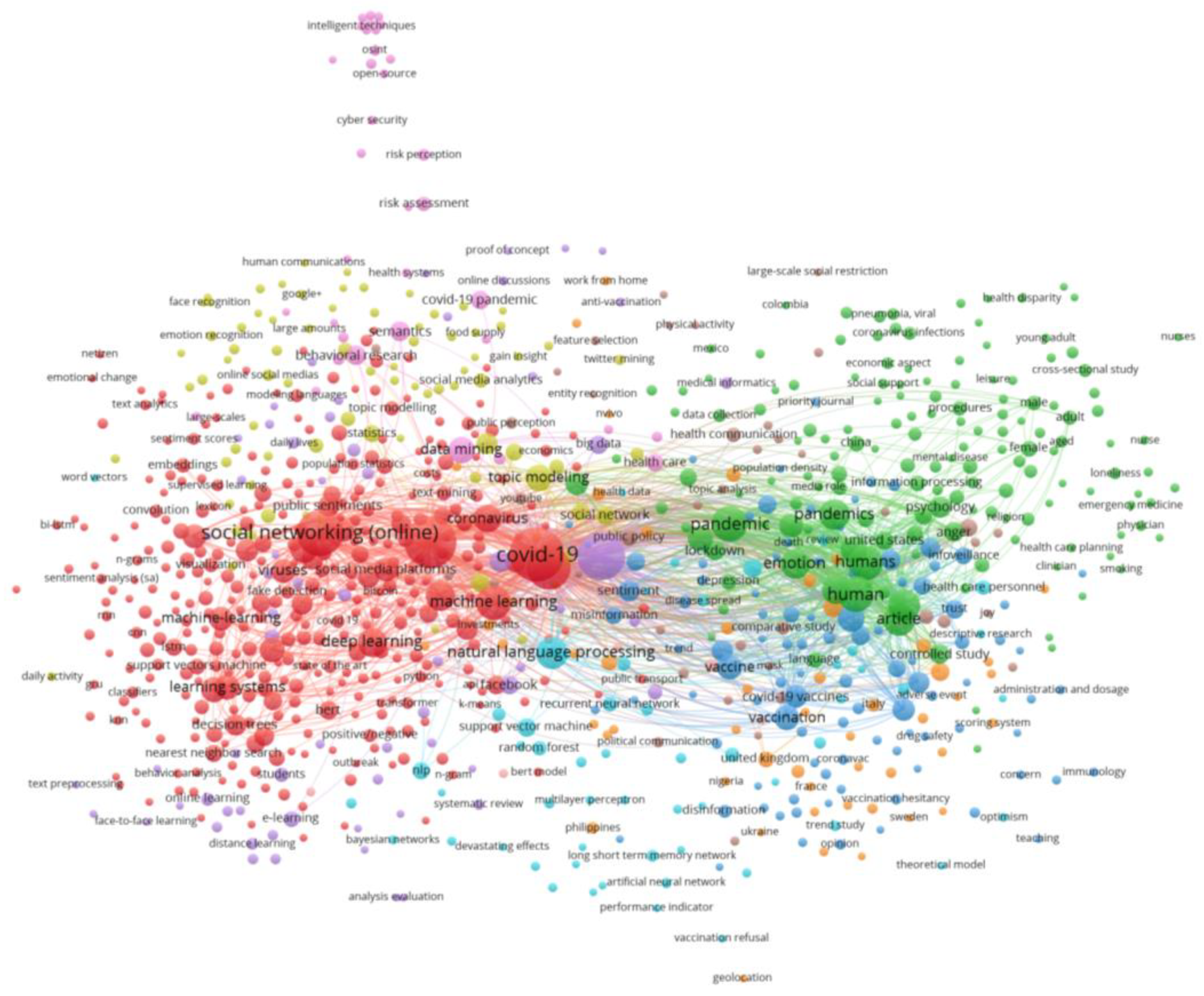
Figure 2.
Hashtag network of Greek tweets in March 2020. The network includes 3,263 nodes (hashtags), connected to 25,010 edges. The 53 nodes with the highest PageRank are named. Colors indicate modularity class. Layout algorithm: Force Atlas2.
Figure 2.
Hashtag network of Greek tweets in March 2020. The network includes 3,263 nodes (hashtags), connected to 25,010 edges. The 53 nodes with the highest PageRank are named. Colors indicate modularity class. Layout algorithm: Force Atlas2.

Figure 3.
Emotional Wheel by Robert Plutchik. Source: https://commons.wikimedia.org/wiki/File:Plutchik-wheel.svg.
Figure 3.
Emotional Wheel by Robert Plutchik. Source: https://commons.wikimedia.org/wiki/File:Plutchik-wheel.svg.
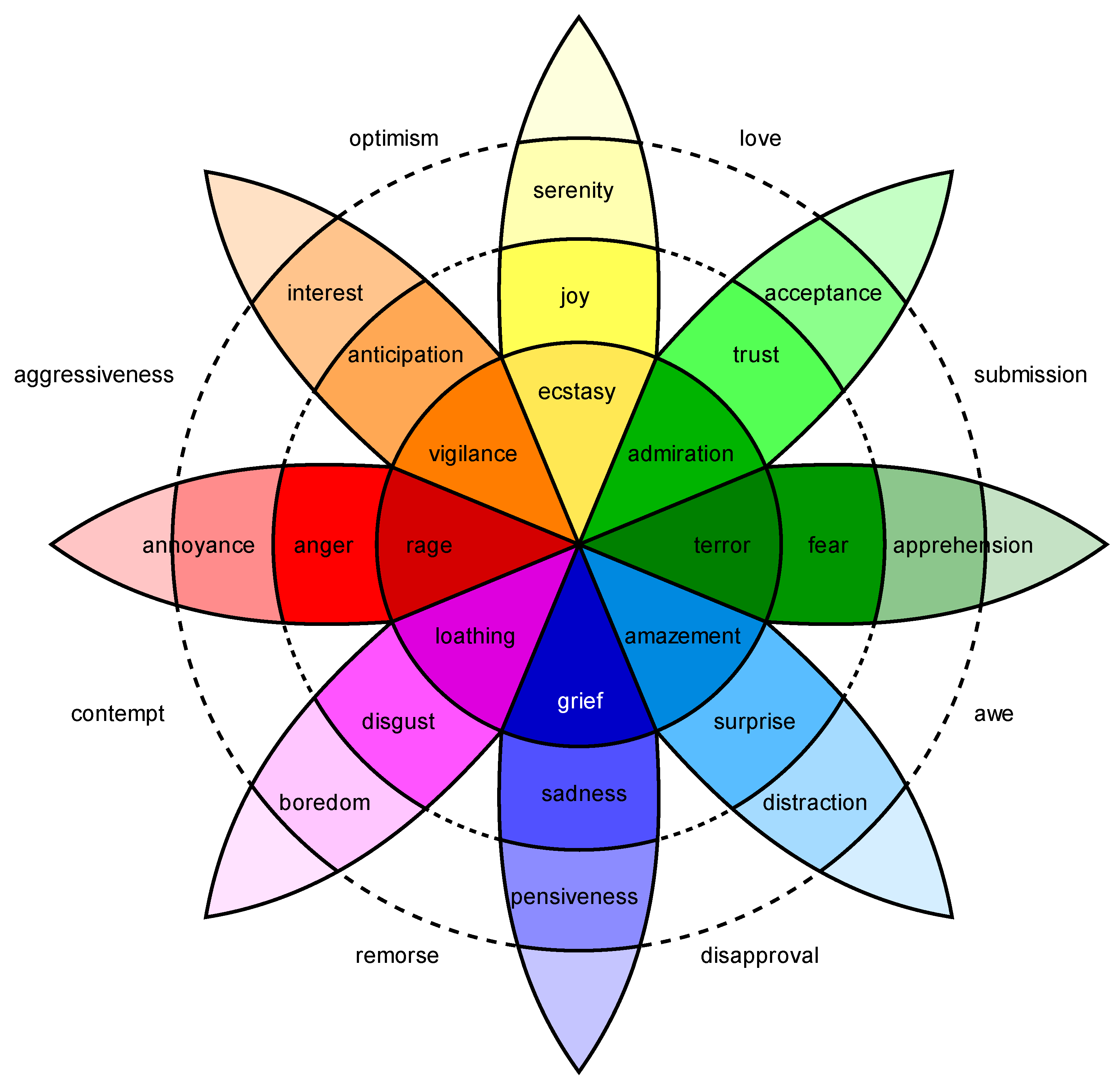
Figure 4.
The evolution of the volume of Greek tweets in the research corpus, compared to the number of cases (infections) per day.
Figure 4.
The evolution of the volume of Greek tweets in the research corpus, compared to the number of cases (infections) per day.
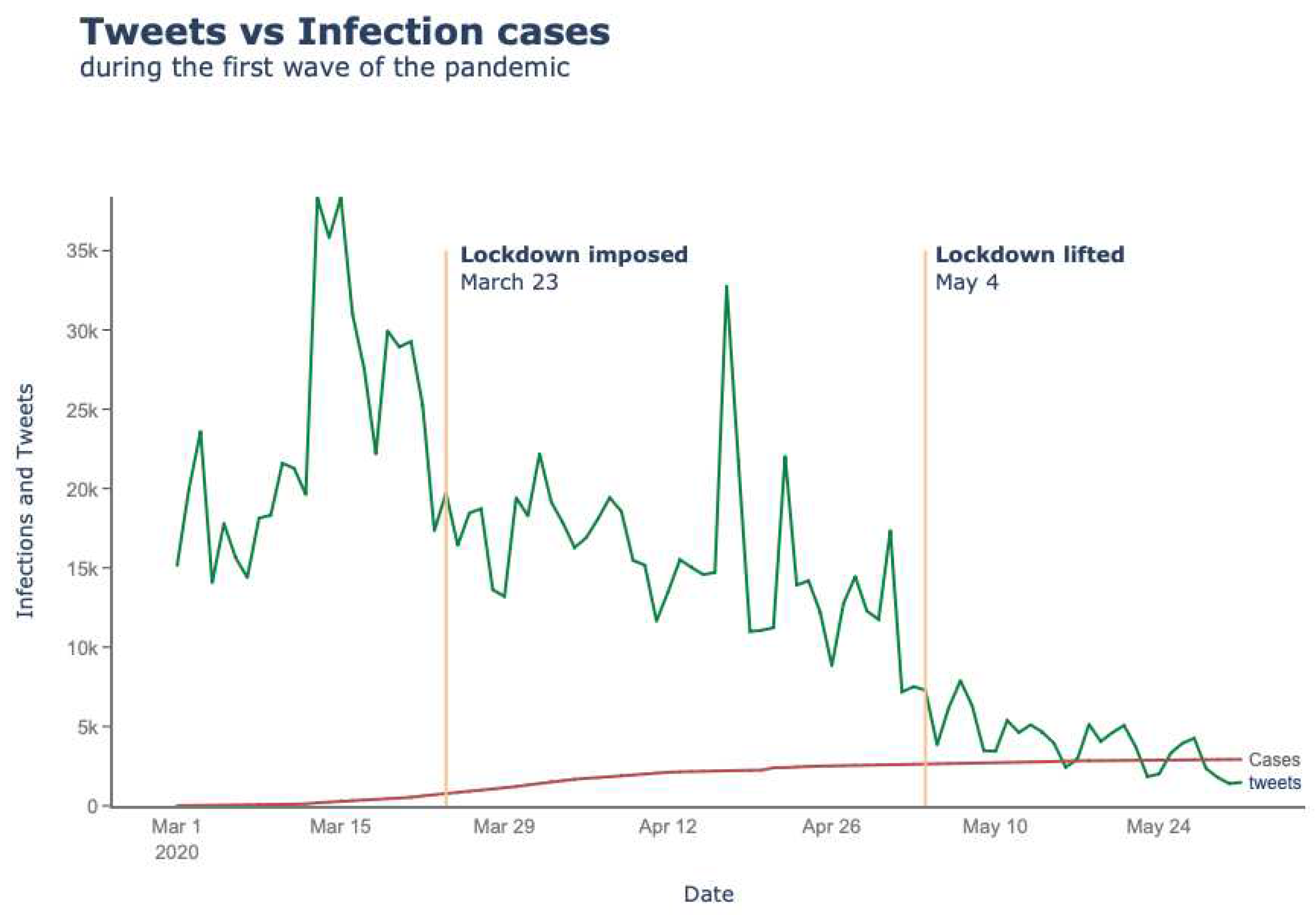
Figure 5.
The evolution of sentiment (negative-positive) between March 1 and May 31, 2020.
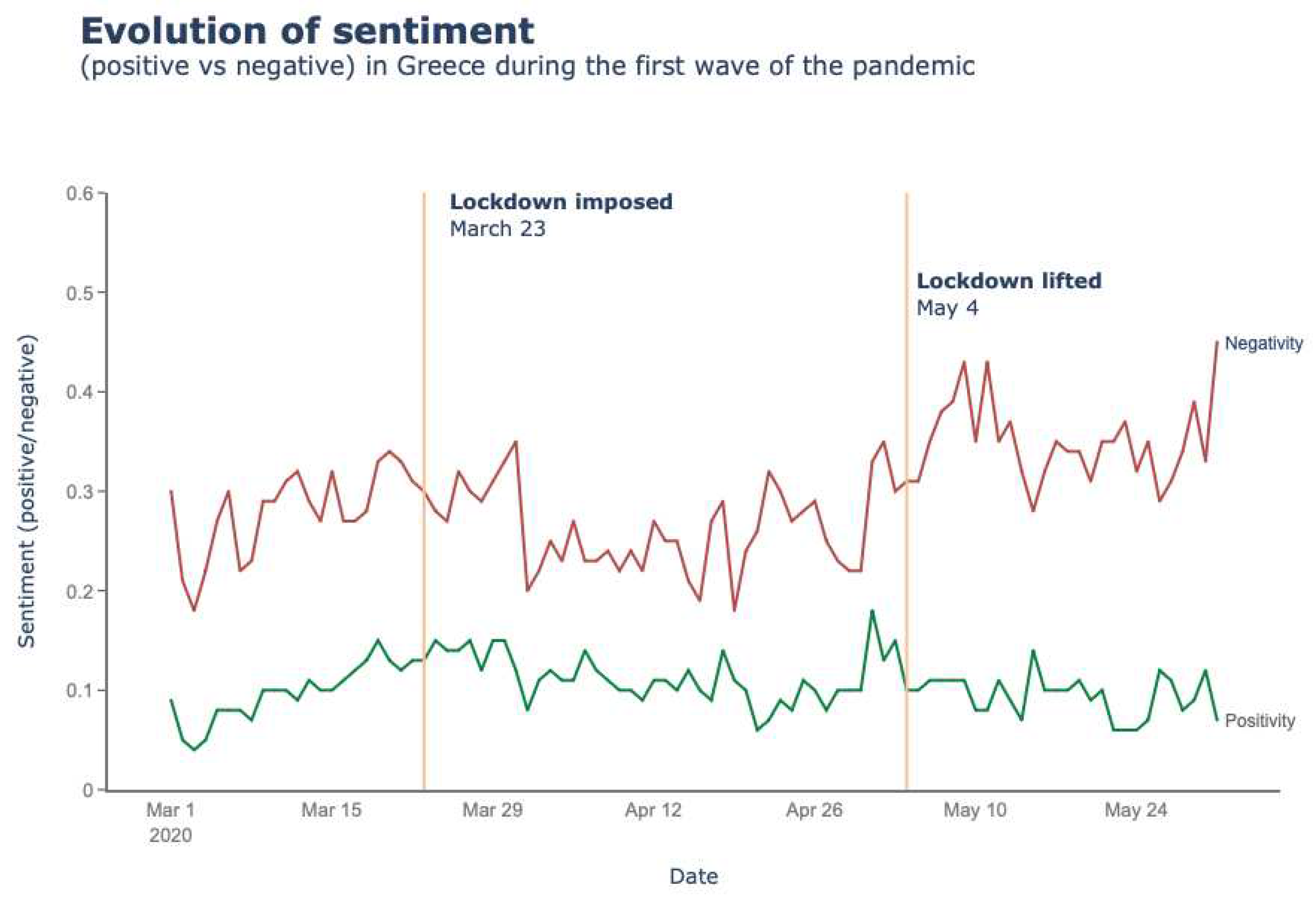
Figure 6.
The fluctuation of the four most intense emotions expressed in the Greek tweets during March 2020.
Figure 6.
The fluctuation of the four most intense emotions expressed in the Greek tweets during March 2020.
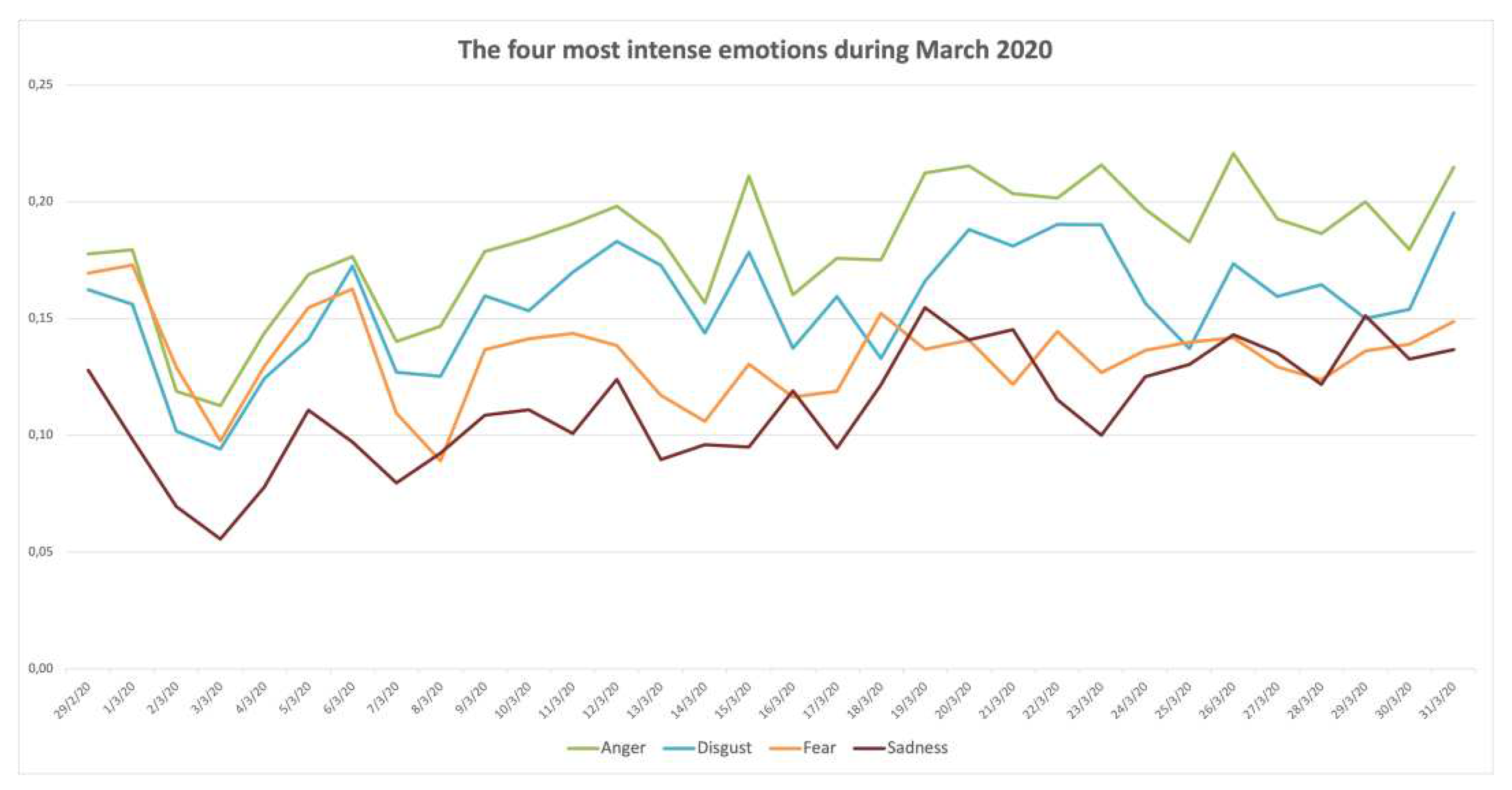
Disclaimer/Publisher’s Note: The statements, opinions and data contained in all publications are solely those of the individual author(s) and contributor(s) and not of MDPI and/or the editor(s). MDPI and/or the editor(s) disclaim responsibility for any injury to people or property resulting from any ideas, methods, instructions or products referred to in the content. |
© 2024 by the authors. Licensee MDPI, Basel, Switzerland. This article is an open access article distributed under the terms and conditions of the Creative Commons Attribution (CC BY) license (https://creativecommons.org/licenses/by/4.0/).
Copyright: This open access article is published under a Creative Commons CC BY 4.0 license, which permit the free download, distribution, and reuse, provided that the author and preprint are cited in any reuse.
MDPI Initiatives
Important Links
© 2024 MDPI (Basel, Switzerland) unless otherwise stated

